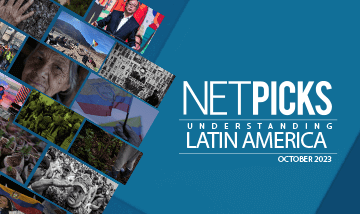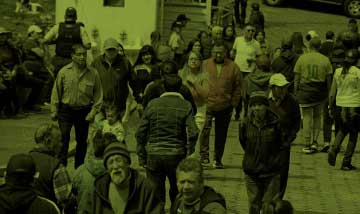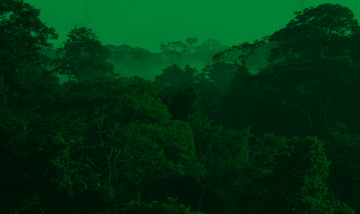Índice
Understanding Latin America
Dear readers and colleagues, this month we bring you five articles that reflect the reality of Latin America: one from Peru, Ecuador, Venezuela, and the Dominican Republic, plus an analysis of the Escazú agreement on protecting the region’s environmental defenders.
- With Pedro Castillo, Peru has a chance to vanquish fujimorismo
- How the right returned to power in Ecuador
- U.S. republicans left a minefield in Venezuela
- Dominican Republic: a wall of division
- Escazú agreement set to bring environmental justice down to earth
.
WITH PEDRO CASTILLO, PERU HAS A CHANCE TO VANQUISH FUJIMORISMO
Following two decades of voting for the anti-Fujimori candidate, regardless of political stripe, the only thing Peru has to show for it, says the author, is that every single former president has been convicted of corruption charges. But this time, he proposes, the surprise winner of first round of Presidential voting, Pedro Castillo, who only weeks before was only polling 2%, has a real chance of putting paid to Fujimorismo. The second place finisher, Keiko Fujimori, former President Alberto’s daughter, and inheritor his political machine, is presently the least popular politician in Peru. This represents an historic opportunity, and if Castillo wins he would also disrupt the right-wing political currents in Congress, held together by Keiko Fujimori’s ‘Popular Force’. For the left, however, the matter is not straightforward. Castillo’s party is Marxist Leninist, which some associate with authoritarianism, and in contrast to the other major left candidate, Veronika Mendoza, Castillo is deeply conservative on social issues such as gender, abortion, and same sex marriage. This, says the author, should probably be viewed in the social context of the marginalized south and center of the country where the majority of his support lies, and the fact that Peru is one the Latin American countries where religious fundamentalism has made the greatest inroads into national politics. On the other hand, the two candidates do coincide on other issues. Both have proposed a second agrarian reform, a constitutional assembly, and the scrapping Alberto Fujimori’s 1992 constitution. Whether Mendoza and others on the more skeptical left will eventually support Castillo, putting aside their differences, is one of the crucial aspects of the upcoming second round vote.
Nicolas Allen, April 16th, 2021
https://www.jacobinmag.com/2021/04/pedro-castillo-peru-presidential-elections-fujimori
.
HOW THE RIGHT RETURNED TO POWER IN ECUADOR
The second round of the Ecuadorian presidential elections on April the 11th featured two candidates, the right wing Banker Guillermo Lasso and Andres Arauz, the candidate of Rafael Correa and his followers. In practice, allegations of fraud made after the first round by the third place finisher, Yaku Pérez, representing the political party Pachakutik, made him a de facto candidate. The first round success of Pachakutik contradicted all forecasts and political calculations, giving it the second largest presence in the National Assembly after the correista block. Perez’s decision to not tip the scales in favor of one of the two finalists, but call for a null vote, was a challenge to both. Lasso, of the Creating Opportunities movement (CREO) finally prevailed with 52.36 % of valid votes against Arauz’s 47.64 %, while the null vote came in at a respectable 17%. The problem for Arauz was his inability to distance himself from the image of corruption and authoritarianism attached to Correismo, a fact that had a clearly negative impact on his campaign. As for the future, says the author, “the shadow of electoral fraud and the scant legitimacy of Lasso’s coming administration make the Indigenous movement a fundamental political player.” For now, he states, Pachakutik has “recouped the banner of the Left from Correísmo” while admitting that the latter “will not be deterred in its attempt to position itself as the opposition to the Lasso government and rehabilitate its diminished progressive image.”
Juan Cuvi, April 15th, 2021
https://nacla.org/ecuador-
.
U.S. REPUBLICANS LEFT A MINEFIELD IN VENEZUELA
Venezuelan life is highly dependent on diesel. The transportation of food, medicine, and passengers depends on it, as the country does not have rail lines and gasoline is used only in private vehicles. As a result, a new problem of diesel shortages, particularly in regions outside the capital, could lead to serious hunger in the country. The national oil company, PDVSA, used to produce diesel for national consumption and export, but at the end of 2020 the company was only producing some 25,000 barrels of the 100,000 now needed to supply the national market. The reason for the crisis is that Elliott Abrams, the Trump government’s special representative for Venezuela, included diesel in the list of sanctioned items five days before Trump left office. Crude oil swaps for diesel had allowed the Maduro regime to continue to receive sufficient fuel to keep industry supplied, but the situation has now changed, and the situation is becoming serious. The new context could prompt reaction from activist groups in the U.S. itself, leading to pressure on President Biden to revise his Venezuela policy. It is not even good news for the Venezuelan opposition, as it is now even more difficult to deny the responsibility of both the U.S. government and the radical opposition, led by Juan Guaido, that has been calling for sanctions.
Ociel Alí López, March 31st, 2021
https://nacla.org/venezuela-diesel-sanctions-trump
.
DOMINICAN REPUBLIC: A WALL OF DIVISION
On February the 27th, the President of the Dominican Republic, Luis Abinader, announced plans to build a high-tech border wall along 190 kilometers of the 391 kilometer Dominican-Haiti frontier. It was designed he said, to put an end to the ‘serious illegal immigration problems, drug trafficking and the transit of stolen vehicles. Construction is slated to begin later this year, and the final result, expected in two years, is set to include double perimeter fencing in the most ‘conflictive’ zones with facial recognition technology, digital fingerprinting technology and infrared cameras. Sixty kilometers of the fence has already been built. Creole-and-French-speaking Haiti on the Western side of the island is the poorest nation in the Western hemisphere, while on the other side, the Spanish-speaking Dominican Republic is the fastest growing economy in Latin America and the Caribbean. Tens of thousands of Haitians have consequently been relying on informal employment in their neighboring country as a means of survival. According to estimates, between 650,000 and one million Haitian immigrants were resident in the Dominican Republic as of 2018; however, the Dominican Republic suspended temporary legal status for more than 150,000 Haitian workers in response to the Covid-19 pandemic. Protests against President Jovenal Moise’s government have been going on in the Haitian capital of Port-au-Prince since early February.
Jessica Pandian, April 20th, 2021
https://lab.org.uk/dominican-republic-a-wall-of-division/
.
ESCAZÚ AGREEMENT SET TO BRING ENVIRONMENTAL JUSTICE DOWN TO EARTH
According to Global Witness’ most recent annual survey, more than two-thirds of the 212 environmental defenders killed worldwide were from Latin America and the Caribbean. The Escazú agreement adopted in Escazú, Costa Rica on March the 4th, 2018, is a binding treaty that aims to protect environmental human rights defenders in the region. And after a recent round of ratifications – Argentina and Mexico signed off in January of this year – the treaty can move to the implementation stage. Coming into force on Earth Day, April 22, 2021, the agreement obliges member states to prevent and investigate attacks against those who protect and defend environmental rights. Parties to its terms must provide reparations to victims of violence resulting from their peaceful resistance to unscrupulous development schemes. With 20 killings in 2020, Honduras is one of the most dangerous countries in the world for rights defenders, also accounting for at least 120 defenders killed between 2010 and 2017. Next on the list are Brazil, Colombia, Guatemala, and Mexico, and of these only Mexico has ratified the treaty. The agreement also requires member states to “ensure the public’s right of access to environmental information in its possession, control, or custody in accordance with the principle of maximum disclosure.”
Talli Nauman, April 20th, 2021
https://www.counterpunch.org/2021/04/20/escazu-agreement-set-to-bring-environmental-justice-down-to-earth/





